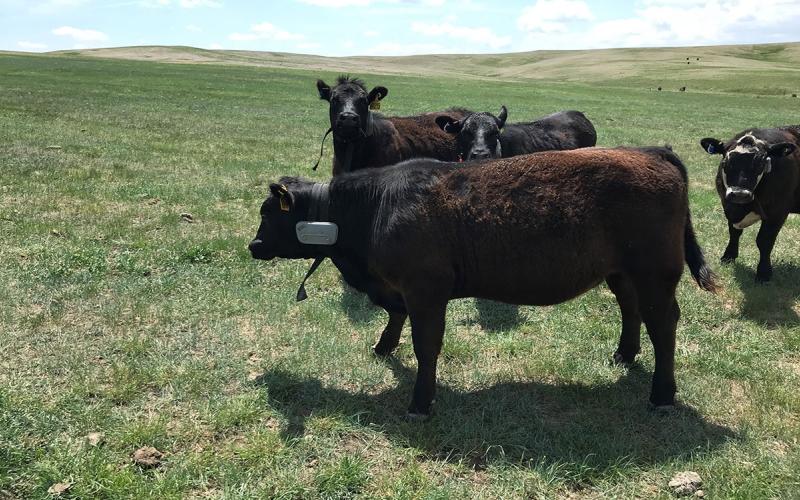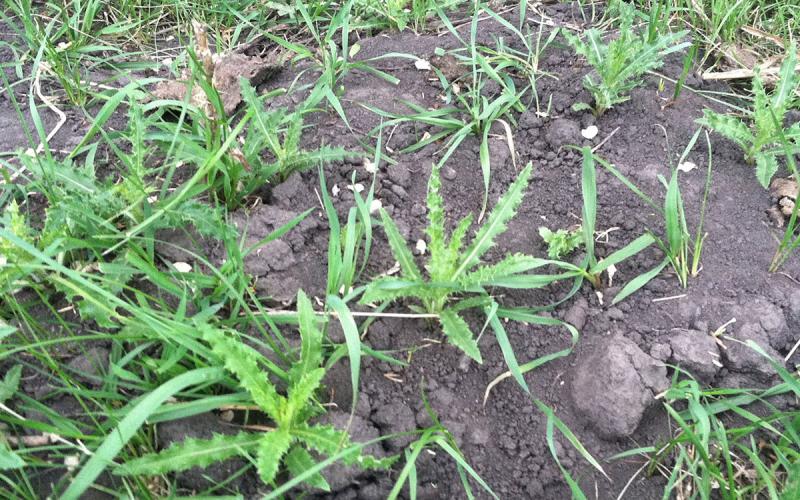
South Dakota Invasive Plants
Canada goldenrod is a native flowering plant in South Dakota, but it is generally considered as a grazing ‘increaser’ and is relatively undesirable by landowners at high densities. Canada thistle and perennial sow thistle are both common noxious weeds in South Dakota requiring that managers control the production and spread of seed.
S.D. Distribution Maps:
- Canada thistle, S.D. Department of Agriculture
- Perennial sow thistle, S.D. Department of Agriculture
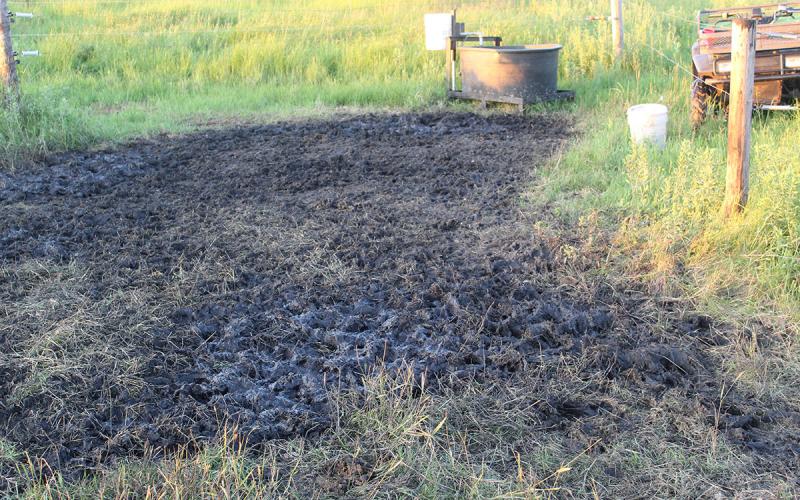
In all three cases, poor grazing management, such as season-long grazing or heavy soil impacts from livestock, are often the culprit for infestations to start or persist (Figure 1 and Figure 2). A common assumption is that chemical application is the only solution to weed issues stemming from a lack of understanding of the interaction of grazing and plant biology. The use of targeted grazing can help control these plants in pastures once managers understand the importance of timing, intensity, and livestock habits.
Livestock will graze Canada goldenrod, Canada thistle, and perennial sow thistle, and the plants are nutritious at certain times of the year. A review of several reports and our own research and observations confirm that at certain times these plants have crude protein, total digestible nutrients, and invitro dry matter digestibility concentrations similar to alfalfa and other common forages.
When and How to Graze These Plants in South Dakota

Canada Goldenrod
Our work here at SDSU Extension suggests that Canada goldenrod plants contain high nutritive value, with the tops of the plants consistently similar to alfalfa. We found that we can train cows to eat Canada goldenrod and that mature cows with calves naturally utilize Canada in early to mid-June, nipping plant tops. This use is nearly imperceptible as the plant continues to grow and flower after the bud is nipped off, leading many to assume cattle do not utilize the plant. A small high intensity – short duration trial also confirmed that cattle will forage on goldenrod extensively under restricted grazing in August, but it is unclear as to the long-term impact on the goldenrod plant community (Figure 3). Grazing managers should target goldenrod plants in early to mid-June, prior to the onset of flowering (usually late July and August).
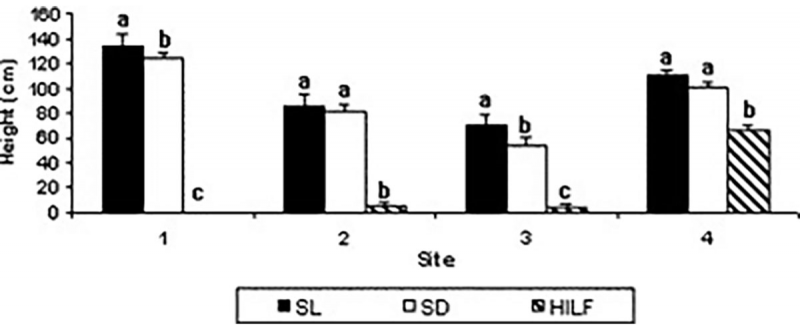
Canada Thistle
Nutritive value of Canada thistle is perhaps the most well documented of the three plants discussed here. The primary issue for Canada thistle management is when and how to target the plant.
Research from Alberta compared three grazing systems for Canada thistle control: 1) season long, 2) low intensity - high frequency, and 3) high intensity - low frequency (Figure 4).
They found that season long grazing where livestock are turned out and not rotated or managed resulted in increased Canada thistle populations and reduced overall forage yield.
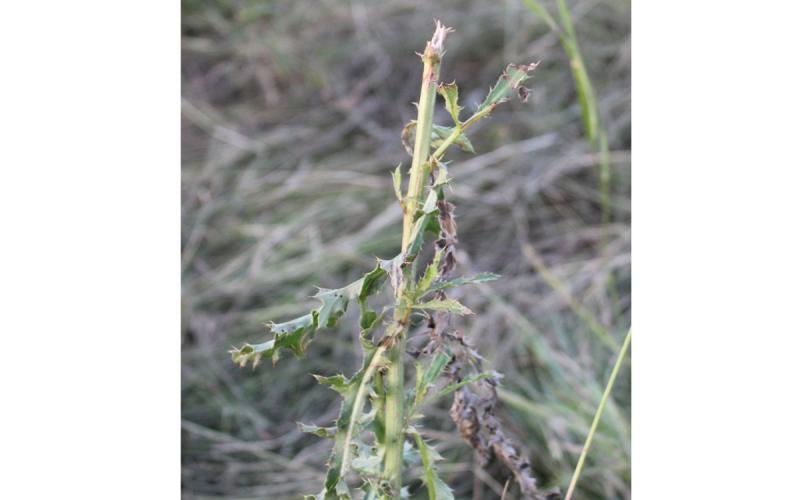
Conversely, high intensity - low frequency grazing reduced Canada thistle shoot density, biomass, and flowering and resulted in greater weed suppression.
Two ‘intense’ defoliations of Canada thistle during the growing season for 2 to 3 years in succession dramatically reduced the Canada thistle population, and the plants that remained stayed vegetative (did not flower) and had higher forage quality. This system proved better for Canada thistle control than did low intensity – high frequency (Figure 4 and Figure 5).
Short Duration – High Intensity Grazing
Short duration - high intensity grazing can control Canada thistle over time. The near portion of the grazing cell in Figure 6 is likely impacted too much, and it may result in additional weed issues due to exposed soil and lack of residual vegetation.
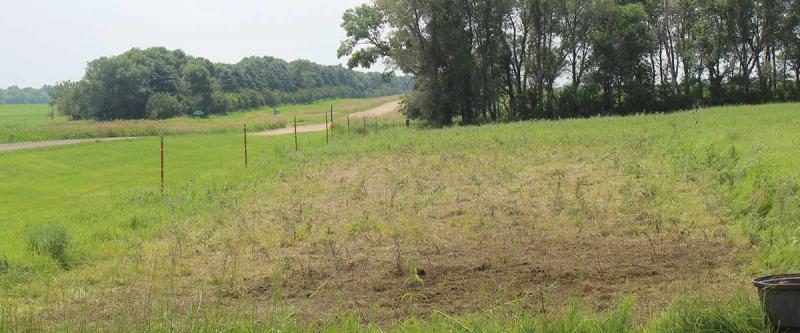
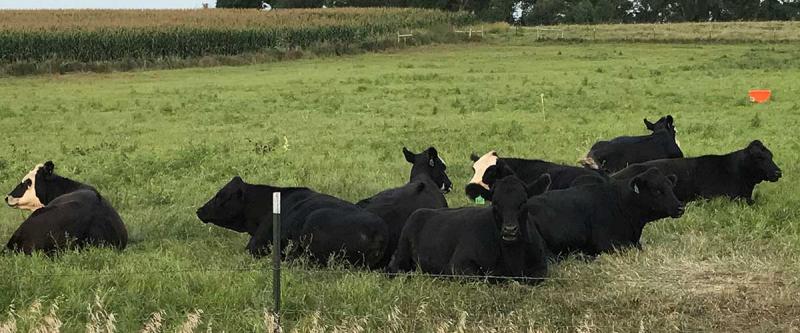
General Observations
As a grassland manager, I have spent years manipulating and observing livestock for Canada thistle control, and have come to a few general observations that are also supported in reports:
- Canada thistle has the potential to invade anywhere there is exposed soil. Minimizing livestock soil damage is key in preventing new infestations.
- Mature cows will forage on Canada thistle buds in mid-June and may consume a great deal of the plant at certain times and for about 7 days between about June 10 and July 1. However, the exact timing of this period of more intensive use is not always predictable in this three-week period.
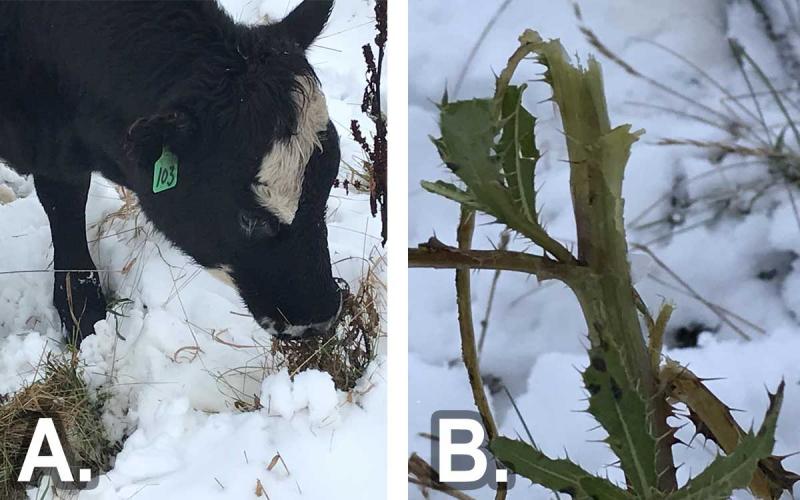
- Cows will teach calves to forage on thistle and other plants.
- Yearling cattle will learn to utilize Canada thistle if given the opportunity.
- The key to Canada thistle control with livestock is to first stop the grazing practices that promote thistle expansion (season long grazing, heavy impacts to soils). The second step is to concentrate animals for high-intensity-short duration grazing during bud stage before thistle plants flower.
- Finally, I’ve also observed that livestock often do not re-graze Canada thistle in September, even though the plants might appear green and palatable (Figure 7). Interestingly, yearlings turned out into a stockpiled pasture in early October were observed to select both dead and decadent and younger green Canada thistle plants, presumably for their higher protein and nutrition content compared to surrounding forages (Figures 8).
Perennial Sow Thistle
Perennial sow thistle is very palatable and is will be selected by cattle if they are exposed to the plant at the correct time of the year. Largely, this information is based on observation over 10 years with different groups of yearling cattle. I’ve observed consistent targeting of perennial sow thistle from late July through mid-August during the bud and flowering stage of the plant. My observations suggest that yearlings (and likely cows) will generally avoid the plant if grazing in a pasture with perennial sow thistle before this time. And, if they do forage on the plant in early July, the plant may continue to grow and flower. However, if targeted in the late July to mid-August time period, livestock often consume the entire plant, not just the flowers, and thus there is very little opportunity for the plant to rebound, especially if repeated for several years in a row. Targeted grazing may be necessary if there are large infestations, but generally cattle appear to seek out the plant during this period. Finally, once flowers start maturing, grazing selection drops off dramatically.
Additional Resources:
- Canada Thistle: Profile, Distribution Map. S.D. Department of Agriculture.
- Perennial Sow Thistle: Profile, Distribution Map. S.D. Department of Agriculture.
- Canada Thistle Biocontrol. S.D. Department of Agriculture.
- Integrated Pest Management. S.D. Department of Agriculture.
- Canada Thistle Plant Profile. USDA NRCS.
- Perennial Sow Thistle Plant Profile. USDA NRCS.
- Biological Control of Canada Thistle in Temperate Pastures Using High Density Rotational Cattle Grazing. Bruijn and Bork. (2006).
- Canada Thistle is Alfalfa’s Equal. On Pasture, R. Gilker. (2013).
- Forage Nutritive Value and Palatability of Perennial Weeds. Marten et al. (1987).
- Forage Value of Pasture Weeds. Oregon State University Extension.
- Allelopathic Activity of Canada Thistle (Cirsium arvense) in Colorado, Stachon and Zimdahl (1980).
- The Nutritive Value of Common Pasture Weeds and Their Relation to Livestock Nutrient Requirements . Virginia Cooperative Extension Service (2009).


